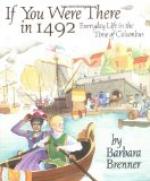The next day he proceeded westwards along the southern part of Trinidad, until he arrived It the westernmost point, which he called “La punta de Arenal;” and now he beheld the gulf of Paria, which he called “La Balena” (the gulf of the whale). It was just after the rainy season, and the great rivers which flow into that gulf were causing its waters to rush with impetuosity out of the two openings [20] which lead into the open sea. The contest between the fresh water and the salt water produced a ridge of waters, on the top of which the admiral was borne into the gulf at such risk, that, writing afterwards of this event to the Spanish court, he says, “Even to-day I shudder lest the waters should have upset the vessel when they came under its bows.”
[Footnote 20: The Boca del Drago and the Boca de la Sierpe.]
Columbus mistakes the continent for islands.
Previously to entering the gulf, the admiral had sought to make friends with some Indians who approached him in a large canoe, by ordering his men to come upon the poop, and dance to the sound of a tambourine; but this, naturally enough, appears to have been mistaken for a warlike demonstration, and it was answered by a flight of arrows from the Indians.
The admiral, still supposing that he was amongst islands, called the land to the left of him, as he moved up the gulf, the island of Gracia; and he continued to make a similar mistake throughout the whole of his course up the gulf, taking the various projections of the indented coast for islands. Throughout his voyage in the gulf, Columbus met with nothing but friendly treatment from the natives. At last he arrived at a place which the natives told him was called Paria, and where they also informed him that, to the westward, the country was more populous. He took four of these natives, and went onwards, until he came to a point which he named Punto de Aguja (Needle Point), where, he says, he found the most beautiful lands in the world, very populous, and whence, to use his own words, “an infinite number of canoes came off to the ships.”
Proceeding onwards, the admiral came to a place where the women had pearl bracelets, and, on his enquiring where these came from, they made signs, directing him out of the Gulf of Paria towards the island of Cubagua. Here he sent some of his men on shore, who were very well received and entertained by two of the principal Indians. It is needless to dwell upon this part of the narrative. Very few of the places retain the names which the admiral gave them, and, consequently, it is difficult to trace his progress. He began to conjecture, from the immense amount of fresh water brought down by the rivers into the Gulf of Paria, that the land which he had been calling the island of Gracia was not an island, but a continent, of which fact he afterwards became more convinced. But little time was given him for




